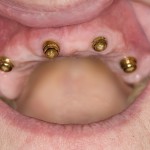
For edentulous patients complete dentures are the most common methods of rehabilitation to restore function and aesthetics. They do however have their limitations and prosthesis retained by dental implants are becoming a more common method of rehabilitation for this group of patients. However various recommendations related to the number of implants required to support complete arch rehabilitation have been proposed.
The aim of this review was to assess whether the number of dental implants per jaw had an influence on implant survival rate and prosthesis survival rate, complication rate, and marginal bone level.
Methods
Searches were conducted in the PubMed/MEDLINE, Scopus, and Cochrane Library databases. Randomised controlled trials (RCTs) and prospective studies, published in English, with follow-up ³ 5 years and studies reporting the number of implants installed per edentulous jaw per patient were considered.
Two reviewers independently selected studies, a single review extracted data which was checked by a second reviewer. Two reviewers assessed risk of bias using the Cochrane tool for RCTs and the Newcastle -Ottawa Scale for non-randomised studies. Implant survival rate, prosthesis survival rate, prosthetic complications, and marginal bone loss were pooled and reported as event rates with 95% confidence intervals.
Results
- 19 studies (6 RCTs, 13 prospective studies) involving a total of 1006 patients were included.
- The mean follow-up time for studies fewer than 5 implants was 6 years and 7.63 years for studies with >4 implants.
| Implant survival rate | Prosthesis survival rate | |
| Fewer than 5 implants | ||
| Both Jaws | 98.7% | 99.5% |
| Mandible | 98.9% | 99.5% |
| Maxilla | 99% | 100% |
| More than 4 implants | ||
| Both Jaws | 96.6% | 89.62% |
| Mandible | 100% | 100% |
| Maxilla | 95.61% | 89.62% |
- The pooled implant failure rate for studies with fewer the 5 implants was 1.4% (95%CI; 1% – 2%) [10 studies] compared with 4.2% (95%CI; 2.3%-7.8%) [10 studies] for studies with more than 4 implants.
- Pooled prosthesis failure rate for studies with fewer the 5 implants was 1.5% (95%CI; 0.6%-3.7%) [ 6 studies] compared with 9% (95%CI; 5%-15.8%) [5 studies] for studies with more than 4 implants.
- Pooled prosthesis complication rate for studies with fewer the 5 implants was 19.9% (95%CI; 9.5%-37%) [ 8 studies] compared with 24.5% (95%CI; 11.7%-44.4%) [7 studies] for studies with more than 4 implants.
- For marginal bone loss in complete arches with fewer than 5 implants per jaw, the pooled weighted mean was 1.22 (95%CI; 0.26 – 2.18) [2 studies] For complete arches with more than 4 implants per jaw, the pooled weighted mean was 1.46 (95%CI; 0.558 – 2.367).
Conclusions
The authors concluded: –
The current systematic review indicated no relationship of the number of implants used to support a complete-arch prosthesis with implant survival rate, prosthesis survival rate, prosthesis complications, or marginal bone loss in studies with follow-up periods of between 5 and 15 years.
Comments
While the reviewers have searched a broad range of databases for this review restricting inclusion to those published in English may have excluded some relevant studies. Only 6 RCTS were included in the review with 4 of them being considered at high risk of bias because of a lack of blinding, while this would be difficult to achieve for these types of studies all of the studies also had concerns related to the incomplete outcome reporting. While the authors report little difference between restorative approaches using fewer than 5 implants or more than 4 implants they do highlight that only two of the included studies were designed as direct comparisons of the number of implants to support full-arch rehabilitation. So while this review suggest that there is little difference in longevity when different numbers of implants are used additional high quality RCTs of appropriate size and duration are required to clarify the evidence.
Links
Primary Paper
de Luna Gomes JM, Lemos CAA, Santiago Junior JF, de Moraes SLD, Goiato MC, Pellizzer EP. Optimal number of implants for complete-arch implant-supported prostheses with a follow-up of at least 5 years: A systematic review and meta-analysis. J Prosthet Dent. 2018 Dec 4. pii: S0022-3913(18)30427-X. doi: 10.1016/j.prosdent.2018.06.001. [Epub ahead of print] Review. PubMed PMID: 30527569.
Other references
Dental Elf – 7 Apr 2017

I wonder at the value of this type of meta analysis where studies have large variances. A match like this would not meet the criteria within a single study so it’s not clear how it meets with a meta type design.
My view would be that although this review has its flaws. It like other reviews can only build on the primary studies.To me it highlights both a lack of information to provide a satisfactory answer to the question about how many implants are needed to support a full arch prosthesis and issues with the underlying quality of the primary studies.